We’re reader-supported. When you buy through links on our site, we may earn an affiliate commission.
I’ve personally used both ConvertKit (now called Kit) and Mailchimp for many years to help bloggers generate revenue.
So, I’ll help you compare ConvertKit vs Mailchimp with a mix of my own experience, data, features, price, and advice based on the type of business you run.
If you’re a content creator (you blog, host videos or podcasts, make courses, write ebooks, etc.) I recommend ConvertKit.
If you’re selling physical products, you might prefer Mailchimp, but not necessarily.
The good news is, whether you choose ConvertKit or Mailchimp, they each offer a free trial so you can try before you buy.
Also, I love the 100% free option with ConvertKit.
Here’s my full breakdown of Mailchimp vs ConvertKit!
Table of Contents
ConvertKit vs Mailchimp Overview
The average open rate for marketing emails is 34.51%.1 This is amazing for us business owners.
On social media, we’re lucky if 2% of our followers even SEE our stuff, much less read/watch/listen to all of it.
With email, your subscribers will see the subject line in their inbox and decide for themselves if they want to open it to read more.
So, your email marketing software is an important decision. Main things you want to do:
- Feel confident your messages aren’t being sent to the spam folder.
- Have stats show you which topics are being opened and which are being ignored.
- Tag each subscriber based on their interests, their country / state / city, etc., so you can send stuff that’s relevant to their lives.
- Have nice-looking and effective forms or pop-ups on your site to ask people for their email addresses.
When I’ve used ConvertKit or Mailchimp, I always look for topic trends. Which topics are our subscribers most interested in? MailChimp Analytics and ConvertKit Insights Dashboard reveal this information.
You can use an email marketing platform like ConvertKit or Mailchimp to send automated email campaigns. And by creating segment lists of recipients, you can target people with the exact message that will get them to react.
But which platform is better for your specific business, Mailchimp or ConvertKit?
I’ll lay out the main differences in the ConvertKit vs Mailchimp conversation.
Both ConvertKit and Mailchimp help you create email campaigns to get opens, clicks, and purchases (or sign-ups for your affiliate programs).
But there are key differences in the Mailchimp vs ConvertKit discussion. So, let’s take a look at the details of each email marketing platform.
What Is ConvertKit and How Does ConvertKit Work?
ConvertKit is an email marketing platform that’s especially geared towards content creators like
- bloggers,
- YouTubers,
- vloggers,
- podcast hosts,
- social media stars,
- course creators,
- influencers,
- skinfluencers, and
- shinflueners (people who get paid for the sexy shins, which, by the way, are way sexier than feet, in my humble opinion.)
But you can use ConvertKit for any type of business really.
FYI: ConvertKit is changing its name from ConvertKit to Kit. But it’s more than a name change. Kit will have its own app store, giving you more tools to help your business. Read my full Kit review to learn more.
Here’s what I think is the most exciting feature that puts Kit, AKA ConvertKit, ahead of much of the competition: their Recommendation Network.

As content creators, we’re all striving to reach more people. ConvertKit introduces your newsletter to people who subscribe to similar newsletters. It makes sense since they already like your topic.
This is a fantastic feature. You can opt out if you don’t want to participate. But this ConvertKit feature can be a game changer for your business.
Here’s a ConvertKit video to see their features:
681,588 creators use ConvertKit. I know. I counted them all.
ConvertKit sends over 2.5 billion emails each month. So, this is a big-time operation. Big-time!
Typical ConvertKit use cases:
- Email marketing. ConvertKit helps you write clean, streamlined emails, and then it sends the emails to people’s inboxes (not their spam folder). Emails sent with ConvertKit have a 99.8% Delivery Rate, which means they almost all appear in the recipients’ inboxes. They also have a 40% Open Rate, so people will actually see what you’re sending them.
- Paid newsletters. With ConvertKit, it’s easy to create a newsletter and collect subscription fees. The software will guide you through the process, and ConvertKit will also act as your credit card processor (for a transaction fee starting at 3.5% + $0.30).
- Digital products. You can design landing pages for digital products (like ebooks, music, or coaching sessions) and then embed the links in your emails. This is a simple way to start making money online. (Wondering what to sell? Read: What can I sell to make money.)
- Link hubs. ConvertKit can help you create a Linktree-style page where you write a bio and then put all your social media links in one place.
For example, if I were to start a pet care blog, I might email my subscribers Weekly Deals on pet care products. I might also upsell subscribers to purchase my pet care ebooks like “How to Relieve Your Dog’s Separation Anxiety – Fast!” and “7 Steps to Give Your Wombat a Pedicure.”

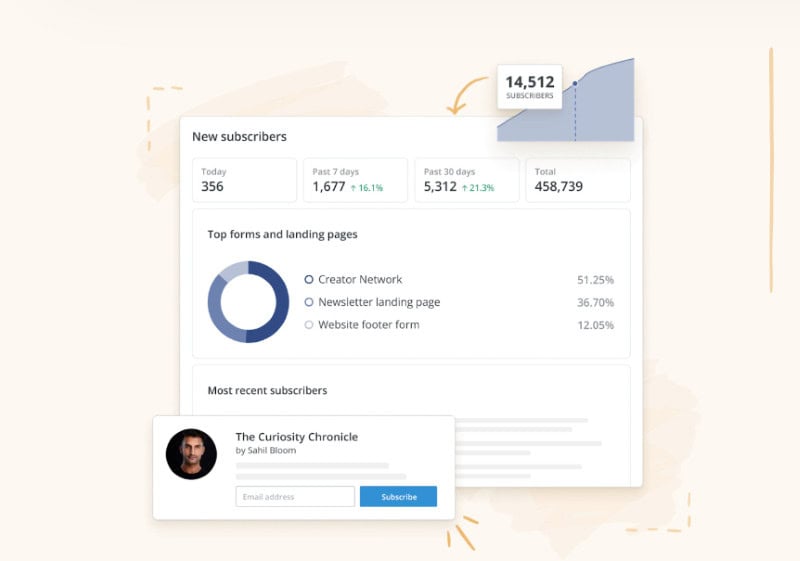

I also really like that Unsplash comes integrated with Kit, so it’s really easy to find free images to insert into your email.
ConvertKit seems to always add new features and improvements. This video walks us through Kit’s new Insights Engagement Dashboard. It’s pretty sick.
In the video, they give you an example. You might see that you’re gaining email subscribers quickly through social media, but the only subscribers who actually buy your products are those you acquired through paid ads.
This is the data you need to help you make smart business decisions!

ConvertKit is adding new features to replace other parts of your business. But if you want to use separate services, check out:
- Best website builder
- Best web hosting services
- Best small business website design
- Best blogging platform
- Best managed WordPress hosting
- RankIQ review (to increase your organic traffic)
What Is Mailchimp and How Does Mailchimp Work?
Mailchimp is an email marketing platform that helps you increase email opens and clicks – which ultimately increases your sales.
As a platform with tons of useful tools, Mailchimp caters to people in a wide variety of industries – from e-commerce to app development. Mailchimp is part of Intuit (the company that runs Credit Karma, QuickBooks, and TurboTax), so you know it’s legit.
Here’s a Mailchimp tutorial:
Here’s a breakdown of my favorite Mailchimp features:
- Email marketing. You’ll get AI-powered tools to help craft your email sequences. Then, Mailchimp will use automation to send the emails at the optimal time.
- Websites. Mailchimp integrates with the site builder Wix to create a website with stylish landing pages for your products.
- Social media marketing. You can use Mailchimp to build a coherent social campaign with scheduled automatic posts.
- SMS marketing. This feature allows you to reach people in their text messages. Messages can be sent automatically after certain triggers (like when someone leaves a product in their cart without checking out, for example).
- Content creation tools. Your email campaigns will require a lot of content – from the emails themselves to the landing pages for each product. Mailchimp’s built-in tools help everything look professional.
- Reporting and analytics. What works, and what doesn’t? You should have data-backed answers to those questions. Mailchimp gives you the key metrics you need. It also helps with A/B testing, letting you experiment with different phrases and ideas.
And the fact that there are so many features makes Mailchimp stand out in the ConvertKit vs Mailchimp debate.
Both Mailchimp and Kit are great for launching a standard email marketing campaign, but if you want the widest possible selection of tools at your disposal, you can stop asking, “Mailchimp or ConvertKit?” Mailchimp is the answer!
For now. But as I said, Kit is committed to adding new features.
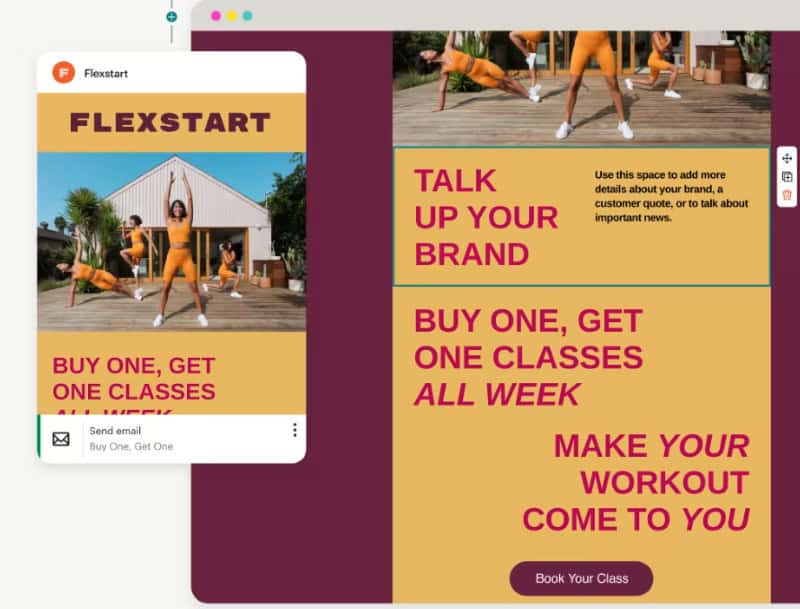
ConvertKit vs Mailchimp Pricing / ConvertKit vs Mailchimp Cost
Pricing is a big part of the ConvertKit vs Mailchimp conversation. Your goal here is to maximize your return on investment (ROI). How do you do that? By finding the option that packs the most useful features into the most affordable package.
Real talk: The pricing models for both companies in the Mailchimp vs Convertkit debate are annoyingly complex.
And the cost ultimately depends on how many people you’re sending your emails to. The more subscribers or contacts you have, the more you’ll have to pay.
Extra Point: To save money with whichever email service you choose, remove the email addresses of people who fail to open at least one of your emails for, let’s say, 60 days. You might also remove the email addresses of people outside of your service area. For example, if you promote credit card offers to US customers, you probably don’t need to be emailing subscribers who live in the beautiful nation of Bhutan.
Take a look at the pricing details I’ve laid out below, and then use the pricing tools on each company’s website to decide how much the plans will cost for someone with your number of contacts/subscribers.
That’s the best way to decide if ConvertKit or Mailchimp will be cheaper for you.
ConvertKit Pricing
ConvertKit has 3 pricing tiers:
- Newsletter (free). You’re limited to a single email sequence with one “visual automation.” You’ll get access to tools like landing page builders, and you can charge for the newsletter if you want. This option is available to anyone with 10,000 subscribers or less.
- Creator (starts at $25 per month). You’ll get unlimited email sequences and unlimited visual automations – giving you the tools you need to launch a real-deal email campaign.
- Creator Pro (starts at $50 per month). Along with unlimited email sequences and unlimited visual automations, you’ll get access to next-level analytics and reporting tools.
The exact price depends on your number of email subscribers. For example, the Creator plan costs $25 a month (if paid annually) with up to 1,000 subscribers – but with 5,000 subscribers, the monthly price goes up to $66.
You’ll also get cheaper prices if you opt for annual (rather than monthly) billing. For example, the most basic Creator plan costs $25 per month when billed annually, but the price goes up to $29 per month if you choose to pay monthly.
Luckily, ConvertKit has a handy-dandy pricing tool on its website, so you can easily see exactly how much each plan costs for a certain number of subscribers.
ConvertKit also offers a 14-day free trial, with no credit card or debit card needed.
Mailchimp Pricing
Mailchimp has 4 different plans to choose from:
- Free. You can only send emails to 500 contacts, but you’ll get access to Mailchimp’s email tools, and you can send up to 1,000 emails each month.
- Essentials (starts at $13 per month). You can send emails to more contacts, and MailChimp’s branding won’t appear on the content.
- Standard (starts at $20 per month). You can send even more emails, let more users access the platform, and access more tools related to social media and SMS marketing.
- Premium (starts at $350 per month). With unlimited contacts and the resources to scale fast, this plan is designed for big companies with larger teams.
The specific monthly price for each plan depends on the number of contacts you want to include (both brands in the ConvertKit vs Mailchimp debate have a similar policy).
Let’s take the “Standard” plan as an example since that’s the plan that Mailchimp recommends. If you have 500 or less contacts, you’ll pay $13 per month. But with 1,500 contacts, the monthly price goes up to $45.
Want to see how much each Mailchimp plan would cost for your business? I’d play around with the pricing tool on Mailchimp’s website. Just select your “contact” count (how many people you want to email) from the drop-down menu, then peruse your options.
Want to try Mailchimp’s Standard plan? Good news – the free trial lasts an entire month!
If you’re struggling because you don’t have enough money to fund your business, check out my resources:
- Best small business loans
- Best banks for small business
- eCommerce credit card
- Best business credit cards
- Financial planning for small businesses
- How to get a startup business loan with no money
- How to flip money fast
- Best small business accounting software
- Lenme review (it’s a peer-to-peer lending app)
- How to make money on OnlyFans – kidding! (or am I?)
ConvertKit vs Mailchimp Pros and Cons
MailChimp or ConvertKit? It’s a tough question because each company has a lot to offer. These lists of pros and cons should simplify the ConvertKit vs Mailchimp debate.
ConvertKit Pros and Cons
ConvertKit Pros:
- You get awesome automation tools. With ConvertKit’s “visual automation” feature, you can create automated email sequences that guide people toward a purchase.
- You can divide your email list into segments. By giving each segment a tag, you’ll make it easy to carry out a targeted email marketing campaign (and the process is super intuitive).
- The delivery rate is 99.8%. That means the vast majority of the emails you send will land in a person’s inbox, not their spam folder.
ConvertKit Cons:
- The analytics are pretty basic. Want in-depth reports on every aspect of your email marketing campaigns? Then ConvertKit isn’t the best choice in the ConvertKit vs Mailchimp discussion.
- The platform is targeted towards creators. That’s great if you’re a creator, but if you’re running a different type of online business, you might be disappointed.
- The free trial only lasts 14 days. That’s actually not bad by most companies’ standards – but it means ConvertKit loses this portion of the CovertKit vs Mailchimp battle (since Mailchimp’s trial lasts 30 days).
Mailchimp Pros and Cons
Mailchimp Pros:
- Mailchimp is designed for a wide variety of businesses. Whether you’re a solo creator or the manager of a massive company, Mailchimp has a plan that can suit your needs.
- The free trial lasts an entire month. That gives you time to create an email marketing campaign and see if it actually works.
- There are tons of available integrations. You can use Mailchimp alongside Shopify, Wix, Salesforce, and other popular pieces of business-related software.
Mailchimp Cons:
- The free plan only lets you connect with 500 contacts. By comparison, ConvertKit’s free plan allows for up to 10,000 subscribers (score one for ConvertKit in the Mailchimp vs ConvertKit showdown).
- The average open rate is slightly lower. People open 35.63% of the Mailchimp emails they receive. That’s lower than ConvertKit’s open rate of 40%. But those stats are kinda stupid. People open an email based on whether it gets into their inbox (and not in spam), whether they want to hear from you, and the subject line / teaser line.
- You can usually get a free trial with the “Standard” plan. Want the higher-level Premium plan? You’ll probably have to pay. (You can ask for a free trial if you have a “large list size,” but there’s no guarantee they’ll give it to you.)
Whichever software you choose in the Kit vs Mailchimp showdown, rest assured email marketing is a legit way:
- How to make 50k a month
- How to make 30k a month
- How to make 20k a month
- How to make 10k a month
- How to make 20000 dollars a week
- Jobs that pay 1 million dollars a month
- Jobs that pay over 1 million a year
Email marketing is also one of the best low-cost business ideas with high profit. It’s a great business to start with 10k. Or with $0 if you know how to build an audience on social media or YouTube. And it’s one of the most profitable online businesses. Email marketing is a legit way how to turn 10k into 100k. And it’s one of the best business ideas for women.
I worked for a married couple who owned an affiliate marketing blog. And a key revenue-generating component was their email newsletter, which I was responsible for.
We helped our email subscribers solve their problem (how to travel for less money) by educating them about products and services that benefited them and also paid us a commission.
When this couple put their online business for sale, they made millions of dollars.
Email marketing even works if you do it part-time. Here are hobbies to make money. And here’s more information about how to make money online for beginners, such as with referral bonus apps to earn 20 dollars per referral.
ConvertKit vs Mailchimp Reviews
I found a few Reddit threads where people hashed out the ConvertKit vs Mailchimp debate.
In one, James straight-up asked, “Mailchimp or ConvertKit?” James is a self-published author and wants to know which platform would be best to use alongside their Weebly website.
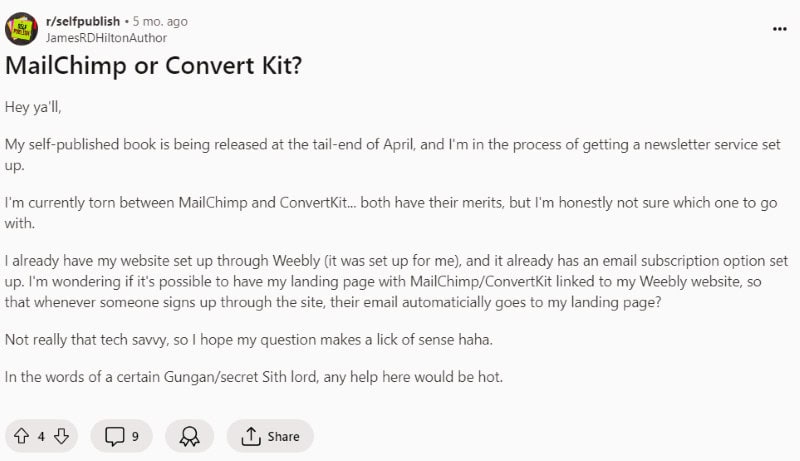
One person responded by suggesting MailerLite – another platform outside the Mailchimp vs CovertKit discussion.
They thought MailerLite was cheaper than ConvertKit or Mailchimp.
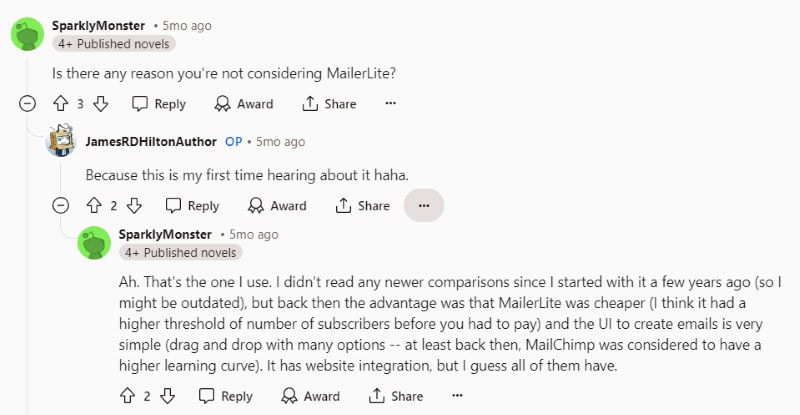
Someone else argued that ConvertKit wins the Mailchimp vs ConvertKit competition. Why? Mainly because “ConvertKit’s free plan allows double the subscribers that Mailchimp’s does.”
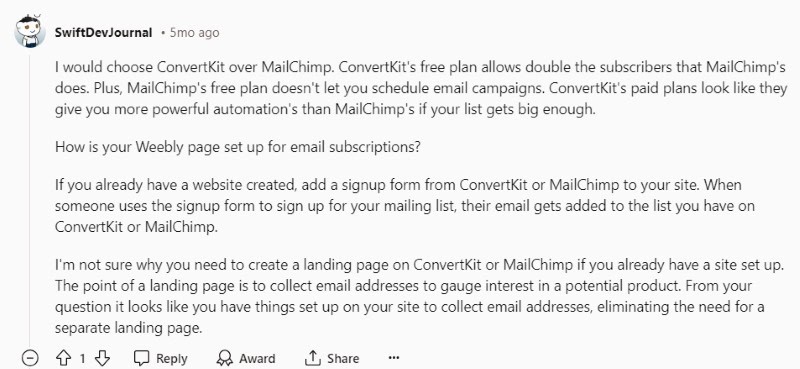
In another Reddit thread, someone asked about the “best email marketing platform.”
Luckily for us, the discussion addressed whether ConvertKit or Mailchimp is the better option.
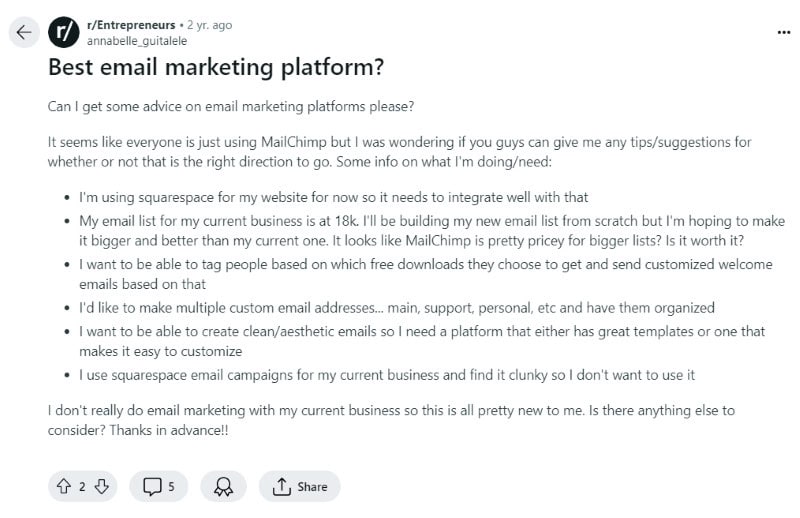
Someone said that ConvertKit and MailerLite are the best options since they “both have better open rates than Mailchimp.”

Another person seconded the vote for ConvertKit, while also noting that Mailchimp has a lot of tools for users in the e-commerce niche.
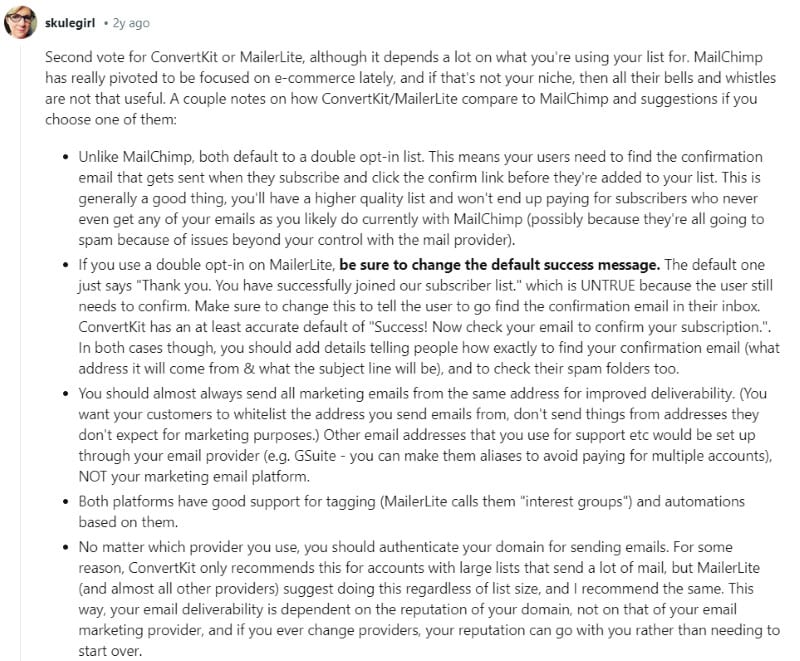
Email marketing is a smart way how to make more money.
Here’s
- How to make 400 dollars fast
- How to make 600 dollars fast
- How to make 700 dollars fast
- How to make 800 dollars fast
- How to make 900 dollars fast
- How to make 3000 dollars fast
- How to make money fast
- How to double 10k quickly
ConvertKit vs Mailchimp: Which Is Better? / Is ConvertKit or Mailchimp Better?
The ConvertKit vs Mailchimp prize fight is over. The judge (me) comes up to the microphone and announces: The winner is… content creators like YouTubers, bloggers, course creators, and podcast hosts, choose ConvertKit.
If you’re selling physical products, ConvertKit can still be a good choice, but investigate Mailchimp, too. The easiest thing to do is to try out ConvertKit’s 100% free option to see for yourself how you like it.
Whether to use ConvertKit or Mailchimp depends on the type of business you’re running.
If you’re a content creator or solopreneur with a relatively simple business model, then ConvertKit is my recommendation. They have an incredible open rate (40%!), and even the free plan gives you what you need to launch an effective email marketing campaign.
But let’s say you’ve got a more complicated business – maybe an online retailer that sells a variety of products. In that case, you’ll need a more sophisticated email campaign with lots of landing pages, and you’ll want to analyze the data from your campaign as closely as you can. For situations like this, MailChimp has a larger selection of the features you’ll need.
So… ConvertKit or Mailchimp? Start by looking at your business model. From there, the choice should be easy.
You know what else is often an easy choice? The decision to turn your business into an LLC to protect yourself from lawsuits and overpaying taxes.
I wrote these to help you:
- Why do you need an LLC
- LLC Checklist – to do it yourself
- LLC 101
- How to avoid using home address for LLC – important for content creators who show their face!
- Best LLC service
- Bizee vs ZenBusiness
Commonly Asked Questions About ConvertKit vs Mailchimp
Alternatives to ConvertKit / Alternatives to Mailchimp?
Here are marketing platforms that you can use instead of ConvertKit or Mailchimp:
- ClickFunnels (check out my ClickFunnels vs Kit guide)
- ActiveCampaign
- Beehiiv (see my Beehiiv vs Substack article to learn more)
- MailerLite
- HubSpot
- Constant Contact
- Xperiencify (learn more in my Xperiencify review)
- Omnisend
- Podia
- Kartra (read: Kartra vs ClickFunnels)
- Campaigner
- Moosend
- Substack (here’s my Substack vs Medium post to learn more)
See my full list of the best email marketing software.
What Is the Difference Between ConvertKit and Mailchimp?
The main difference between ConvertKit and Mailchimp is that ConvertKit is geared towards creators, while Mailchimp is especially useful for e-commerce businesses. Both companies offer a user-friendly platform for email marketing campaigns, and you can safely use either ConvertKit or Mailchimp for your business. Both are reputable companies.
What Is ConvertKit Good For?
ConvertKit is great for creating an automated email marketing campaign. They’ll help you design an email sequence that can turn random readers into paying customers. And 40% of all emails sent with ConvertKit are opened, which is an incredible rate.
Why Not Use Mailchimp?
One reason not to use Mailchimp could be that you want to send emails to a large number of people without paying for the service. Mailchimp’s free plan only lets you send emails to 500 contacts. Meanwhile, ConvertKit is free until you surpass 10,000 subscribers!
ConvertKit vs Mailchimp vs MailerLite?
ConvertKit, MailChimp, and MailerLite all offer the same service: Automated email marketing campaigns. One main difference is the number of subscribers or contacts you can email with a free plan (500 for Mailchimp, 1,000 for MailerLite, and 10,000 for ConvertKit).
Related:
- Kit review
- How to get sponsored by brands
- Online businesses for sale under $5,000
- How to invest 5k in real estate
- Skool review
- Scribehow review
- LearnWorlds review
- Best small business firewall review
- Remote employee training
- Employee training software
- How to make money on Facebook
- How to make money on X
- How to make money on Pinterest
- How to make money as a video editor
- How to make money as a travel photographer
- SEO for travel bloggers
- Therapy for business owners
- Solopreneur marketing
- Highest paying travel affiliate programs
- How to make money on Audible
- How to make money as an independent artist
- Affiliate programs for moms
- What Flips
- Best shipping label printer
- How to make money as an attractive female
- How to make money as an attractive male
- How to make money on OnlyFans as a couple
- How to make money on OnlyFans as a guy
- Relationship affiliate programs
- Best VPN services
Sources:
